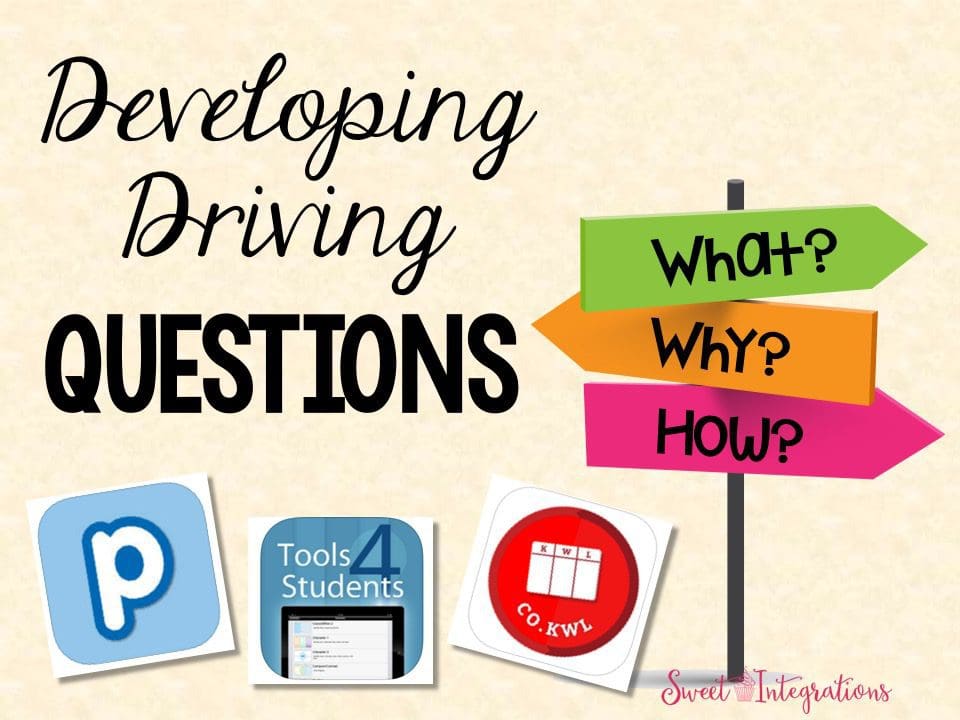
Driving Questions
A “mission Statement” of a project is called Driving Questions, according to Tony Vincent, author of “Crafting Questions That Drives Project“. Vincent (2014) believes “It captures the heart of a project by providing purpose using clear and compelling language.”
Driving questions pose simply state real world dilemmas. They pose predicaments that students find interesting and want to answer. The question drives students to discuss, inquire, and investigate the topic. It should push them toward a production or solution. Students learn important content and skills when investigating the question and sharing their answers, according to Vincent.
You can start with a topic or learn standards to develop a driving question. The driving question should require students to learn skills and content to answer an interesting question.
How to Write a Driving Question in 5 Easy Steps
How to Write Engaging PBL Driving Questions Simply and Clearly article suggests 5 easy steps to write a driving question, and they are:
1. Question:
A project-based learning driving question is a question after all, so it makes sense to have a question written into it. The question should be open-ended. If you ask a question that has one right or wrong answer, the PBL experience is over. Encourage students to think in the upper levels of Bloom’s Taxonomy.
The question could start with “How”, “Should”, “What”, “Could” and so on.
PBL Driving Question Example: How can our senior class create a free, interactive, digital career station for students and other job seekers in the community to make career inquiries seamless and accessible to all?
2. Action-Taker(s)
The action-taker is the person or group that will participate in or execute the experience. This is written into the driving question so that students are clear on who will be involved, including peers, partners, and collaborators
The action-taker might be “I”, “our economics class”, “our neighborhood community”, etc.
PBL Driving Question Example: How can our senior class create a free, interactive, digital career station for students and other job seekers in the community to make career inquiries seamless and accessible to all?
3. Action
The action is what the action-takers will do or create. This is the “what” of the experience. What final product will they make? What service will they provide? This is essentially the final product or information that they will produce that will serve or impact the community.
PBL Driving Question Example: How can our senior class create a free, interactive, digital career station for students and other job seekers in the community to make career inquiries seamless and accessible to all?
4. Recipient
The recipient is an important piece of project-based learning. PBL is authentic, meaning the experience and outcomes should be relevant and impactful to those beyond the walls of the classroom.
An authentic presentation is an important component of project-based learning that distinguishes it from other teaching methods.
Students do not share their final products exclusively with their teacher and class. They share it with the public, not just the public, but also with a public audience relevant to the topic or final product. The person or group that will receive the information or product is written directly into the driving question.
PBL Driving Question Example: How can our senior class create a free, interactive, digital career station for students and other job seekers in the community to make career inquiries seamless and accessible to all?
5. Impact
The impact is the “why”, the purpose, and the ultimate goal of a project-based learning activity. Students often ask me why we do something. Why are we learning this? The impact is their answer.
The impact gives students a sense of purpose and desire to participate in the experience. I felt the impact was a little lost with my self-directed high school students without a driving question.
The impact is what the action-takers wish to impart to the recipient(s) of the final product or information shared.
PBL Driving Question Example: How can our senior class create a free, interactive, digital career station for students and other job seekers in the community to make career inquiries seamless and accessible to all?
Tricky Part of Writing a Driving Question
A Tricky Part of PBL: Writing a Driving Question article by John Larmer, that a good question has the following criteria:
- Engaging for students. It is understandable and interesting to students, and provokes further questions and focuses their inquiry process.
- Open-ended. There are several possible answers, and it cannot simply be Googled.
- Aligned with learning goals. To answer it, students will need to learn the targeted content and skills.
Here are some common pitfalls Larmer points out:
| First Draft of Driving Question | Critique | Revised Version of Driving Question |
| What adaptations do animal species make to survive in various habitats? | Not engaging, because it sounds like a teacher or textbook.. | Could a dog live in the desert? |
| What are the major industries in our state? | Not open-ended, too simple; does not require critical thinking. | Why does our state produce the things it does? |
| How is math used in basketball statistics? | Not engaging enough: too broad, not provocative. | Is LeBron James the best basketball player ever? |
| Which buildings in our county should be classified as historic and protected, because they represent important pieces of our past? | Not engaging, because it uses adult language and suggests the preferred answer. | Does it matter if old buildings in our county are torn down? |
| Should natural areas be developed? | Not as engaging as it would be if it were specific and local. | Should our city build new housing on the land near the river? |
| What were the causes of the U.S. Civil War? | Not open-ended and does not require critical thinking and debate. | What was the most important cause of the U.S. Civil War? |
Specify Role and Product
Larmer notes the product and role could be specified in some projects, and might be useful for students in some cases.
According to Larmer, at the Buck Institute, we talk about two types of driving questions in PBL, and here are some pros and cons for each…
1. Driving questions that explore a philosophical or debatable issue, or an intriguing topic, such as:
- Is there “liberty and justice for all” in our society?
- Could there be life on other planets?
- What should be our immigration policy?
- What does it mean to be a man?
- Does it matter what we eat?
Pros: Highly engaging to students; the kind of question they’ll keep talking about when they leave the classroom. Often resemble “essential questions” found in Understanding by Design and the Coalition of Essential Schools, which teachers may be familiar with.
Cons: Harder to write; may feel like advanced PBL practice because the task and product are not spelled out. Typically found more often in upper grade levels and certain subject areas (e.g., humanities) than others (e.g. math, world languages, career/tech).
2. Driving questions that specify a product to be created or a problem to be solved—to which the students’ role may be added, such as:
- How can we help protect an endangered species in our area?
- How can we reduce bullying?
- How can we create a guide to our community for new immigrants?
- How can we, as historians, create podcasts that tell the story of our city?
- How can we, as medical interns, diagnose a sick patient?
Pros: Easier to write. Helps focus younger students on their task in a project. Roles define the kind of thinking we want students to do (as historians, scientists, etc.), add a real-world element, and can be good for career exploration.
Cons: Can feel less engaging for students; sometimes simply states what the teacher wants students to do. Roles may feel fake to some students; older students in PBL especially may prefer being themselves.
Example of Driving Questions
Here are examples of driving questions from PBL Toolkit.
The next blog explores integrating assessment best practices into PBL
